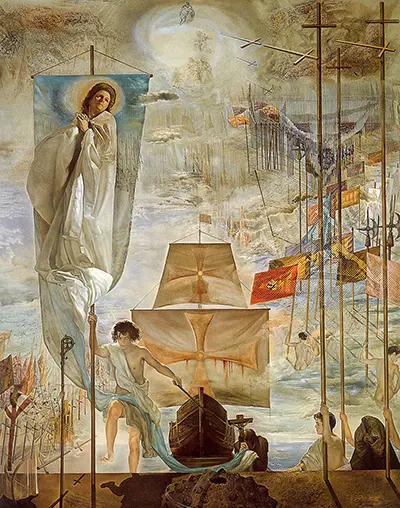The painting, depicting the Genoise explorer’s discovery of the New World, was commissioned by George Huntingford Hartford II and displayed at the Museum Gallery of Modern Art in Manhattan. The museum, situated in the 2 Columbus Circle building, closed in 1969 and the painting was sold at a later date to Reynolds and Eleanor Morse who displayed it at the Salvador Dalí Museum in Florida. A wooden sailing ship, located at the bottom-centre of the painting and visible from the stern-side, represents one of the three ships that made the first transatlantic expedition in 1492. It is likely that Santa Maria, the carrack in which Columbus sailed during his first journey across the Atlantic, is the ship that is featured in the painting but the caravels Pinta and Niña are also possible contenders. The ship has rounded bilges and a raised aftercastle while each of the two square sails, unfurled and hanging from their yards, is emblazoned with a cross.
The explorer, although in his forties at the time in which he first arrived at the Caribbean island of Hispaniola, is depicted as an adolescent boy on the left-hand side of the painting and his youthfulness could signify his discovery of a New World on the other side of the Atlantic Ocean. Dalí, inspired by Roman Catholic mysticism and a devotion to his native land of Spain, creates a dreamlike scene in which both the introduction of Christianity to the Americas and the spread of Spanish civilisation to the New World are celebrated. The unification of Spain, brought about by the marriage of Ferdinand and Isabella, combined the Mediterranean empire of the Catalans with the Atlantic empire of the Castilians. Dalí was of the opinion that Columbus, an an Italian in the service of the Crowns of Aragon and Castile, was born in Catalonia and this belief is embodied in the form of a Catalan flag that resides on the right-hand side of the painting. A female figure, shrouded in white robes and with a halo around her head, hovers in front of the banner that Columbus grasps in his left hand.


